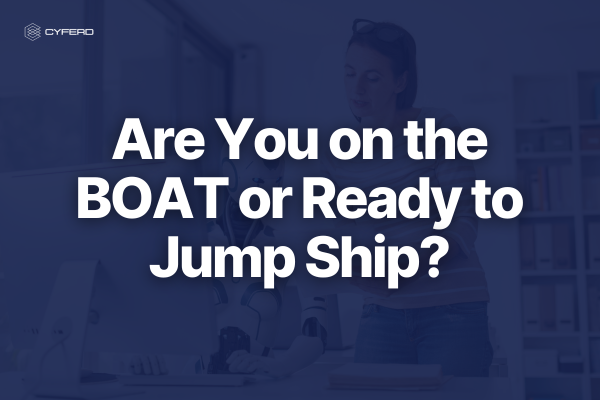AI

Are You on the BOAT or Ready to Jump Ship?
Are You on the BOAT or Ready to Jump Ship?
The enterprise technology landscape is shifting fast — and many organizations are about to be left adrift. Gartner’s latest concept, Business Orchestration and Automation Technology (BOAT), represents the next wave in enterprise evolution. It moves beyond traditional automation and toward a unified, intelligent architecture that orchestrates operations end-to-end [Forbes, 2025].
For years, businesses have tried to automate their way out of complexity. But automating fragments of an organization often creates more silos than it removes. BOAT challenges that thinking — it’s not about automating tasks, but about connecting them into a single adaptive ecosystem.
The question isn’t whether BOAT will redefine enterprise operations — it’s whether your business will be on board when it does.
Below are five practical steps to help your organization prepare for the BOAT revolution.
Step 1: Understand the BOAT Revolution
According to Gartner’s October 2025 Technology Trend Playbook for 2026, BOAT will emerge as a key technology category by 2026, combining orchestration, workflow, and AI-driven automation under one unified layer [Forbes, 2025].
BOAT consolidates previously distinct automation technologies, business process automation (BPA), robotic process automation (RPA), integration platforms-as-a-service (iPaaS), and low-code development, into a cohesive ecosystem centered on process orchestration [Gartner].
Think of BOAT as the captain’s bridge of your organization — providing a single view of your operations, guiding decisions, and keeping everything aligned through changing conditions.
BOAT vs. Traditional Automation
Traditional automation focuses on optimizing specific tasks. Only 8% of organizations have deployed automation at significant scale, with most implementing isolated solutions that fail to deliver transformational value [HBR].
BOAT differs through its emphasis on orchestration strategy. Instead of automating tasks independently, it orchestrates entire business processes across systems and departments. Organizations which have augmented more business processes with automation, AI, and analytics realize greater outcomes in operational efficiency, decision-making, reduced risk, and customer experience [HBR].
Step 2: Assess Your Automation Readiness
Start by creating a comprehensive inventory of your existing automation tools. Document which processes are automated, which systems they touch, and how they integrate. Many organizations discover they have more automation than realized, but much of it operates in silos [MIT Sloan].
Evaluate your workflow efficiency by identifying bottlenecks and manual handoffs. Research indicates that nonphysical core processes involving data collection and analysis often have higher automation potential [McKinsey].
Consider real-world impact: analysis of chemical technicians at a nuclear plant revealed only 25% of their work added value, with the remainder spent on repetitive tasks. Automating these activities can double the share of value-added work [McKinsey].
Step 3: Simplify Your Orchestration Strategy
BOAT isn’t about automating everything—it’s about intelligently orchestrating the processes that matter most. Organizations that elevate automation as a strategic, board-level priority gain lasting competitive advantage [HBR].
Map your critical processes and identify your competitive advantages—whether in content creation, customer experience, or platform capabilities [MIT Sloan].
Align orchestration with strategic objectives. USAA successfully created Auto Circle to help military members purchase vehicles—building integrated experiences through partnerships that delivered financing, dealer negotiations, and insurance in one seamless flow [MIT Sloan].
Start small and scale iteratively. Choose one or two high-impact processes to orchestrate first, learn from implementation, then expand [McKinsey].
Step 4: Invest in Scalable, Unified Platforms
Industry research predicts that “companies with advanced automation programs will obliterate—not merely beat—the competition” [HBR]. Platform consolidation is essential for competitive survival.
BOAT platforms bring together fragmented automation tools, reducing operational overhead and minimizing licensing costs [Gartner]. When automation, workflow management, and data integration exist within a unified ecosystem, orchestration becomes dramatically simpler.
Modern AI-enhanced BOAT platforms enable businesses to orchestrate complex processes while retaining flexibility to build and adapt workflows. The integration of AI agents enhances decision-making and enables autonomous task execution [Gartner].
Low-code capabilities, increasingly enhanced by AI, empower less technical teams to build and adapt workflows efficiently—democratizing BOAT capabilities across your organization [Gartner].
Step 5: Build Adaptability and Continuous Improvement
Technology is only half the equation. As automation grows, organizations increasingly need soft skills such as decision-making, learning, and creativity [HBR].
Successful automation adopters invest in talent and change management programs that address skill gaps [HBR]. Amazon’s “Hands off the Wheel” program elevated employees’ roles by freeing them to imagine and innovate while increasing productivity.
Leadership is the most important part of changing your digital business model [MIT Sloan]. Great leaders must guide transformation, ensuring everyone shares a common framework for discussing orchestration initiatives.
Establish metrics that matter. Real-world examples demonstrate potential: one U.S. health insurer processed claims six times faster, while an agricultural company improved productivity by 75%. A credit card services provider saved more than $160 million by automating workflows [HBR].
BOAT is an ongoing journey. The more business processes organizations augment with automation, AI, and analytics, the greater the returns [HBR].
Conclusion
The BOAT revolution represents a fundamental reimagining of how businesses operate. By understanding BOAT, assessing your readiness, simplifying your orchestration strategy, investing in unified platforms, and building organizational adaptability, you position your organization to lead this revolution.
Companies with advanced automation programs will significantly outperform competitors through transformational differences in efficiency, customer experience, and competitive positioning [HBR].
Preparing for BOAT doesn’t require reinventing your enterprise overnight. Modern unified platforms make the transition practical, scalable, and future-ready. Organizations that begin this journey now will thrive as BOAT platforms mature and become the standard for enterprise automation.
Don’t get left adrift. Get on the BOAT.
Find out more About Cyferd
New York
Americas Tower
1177 6th Avenue
5th Floor
New York
NY 10036
London
2nd Floor,
Berkeley Square House,
Berkeley Square,
London W1J 6BD
